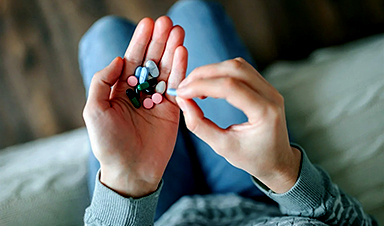In a recent study published in Scientific Reports, researchers reported that drug adsorption on micro- and nano-plastics (MNPs) has severe consequences.
Introduction
Plastic degradation results in the formation of particles with diverse shapes, sizes, and compositions. Research suggests these micro- and nano-sized fragments, viz., MNPs, are present in the environment and enter the human body, even cells.
MNPs can adsorb different substances and deliver them to living organisms. Endocrine disruptors are among the compounds that enter life forms and trigger toxic effects.
Residual drugs in wastewater could enter the human and animal bodies, causing physiological changes. This is particularly concerning in the case of antimicrobials; bacteria exposed to these compounds may develop resistance.
Further, the abundance of resistance genes has increased due to the continuous anthropogenic use (or misuse) of antimicrobials. Besides, MNPs provide a surface for microbes to colonize, serving as vectors for transmission.
About the study
In the present study, researchers assessed the interactions of tetracycline (TC), a broad-spectrum antibiotic, with nanoplastics and whether its biological activity is altered.
Four types of plastics were selected: polystyrene (PS), polyethylene (PE), nylon 6,6 (N66), and polypropylene (PP); these were henceforth referred to as NPs instead of MNPs because their sizes did not exceed the nanoscale. Two approaches were employed to generate TC-NP complexes through chemical computation.
First, the NP was folded from individual polymer chains in the presence of TC through multiple simulated annealing (SA) setups. In the second approach, the free particle (FP) method, the NP was pre-folded through SA, and TC was placed on its surface in different orientations.
All conformations underwent geometry optimization. Further, semi-empirical quantum chemical calculations were performed, and sorption energies and binding modes were derived from these calculations.
Two molecular dynamics simulations were performed for each NP to analyze the solvation behavior and temperature influence of the TC-NP aggregates.
Finally, the researchers evaluated the effects of plastic particles (PE terephthalate (PET), PS, or PE) on the activity of TC in mouse and human cell lines, in which the expression of a fluorescent reporter protein was regulated by a TC-controlled promoter.
Findings
The FP and SA approaches generated 104 aggregates for each NP. The relative total energies of the structures were variable. FP data scattered less since these conformer aggregates varied exclusively in their surface structure. Scattering was the lowest for PE but the highest for PS and PP.
The refolding of TC-NP complexes in the SA method allowed for adjusting the polymer chains to TC and selecting the best possible conformation to maximize the sum of NP-TC and NP-NP interplay.
The FP method yielded considerably less stable structures compared to the SA approach. Overall, the SA approach performed better than the FP method.
On PE, the less polar side of TC was attached to the NP, and the hydroxyl, amide, and carbonyl groups were pointed toward the aqueous solvent. In contrast, on N66, TC alignment was the opposite, and the polar-polar interactions between TC and N66 were stronger than their solvation.
In the SA method, TC was often inside the NP, buried beneath the polymer chains. Further, molecular dynamics simulations of two TC-NP structures of each plastic in water revealed significant differences in the mobilities of the NP chains.
PS chains were the least mobile, with the largest functional groups attached to their polyolefin backbone that may provide steric hindrance or friction.
Likewise, N66 movement was also hindered due to the strong hydrogen bonds between amide groups. The rearrangement of PP was remarkable, with nearly two times greater deviations than the starting structures, suggesting it could rearrange enough to accommodate TC within.
Further, TC diffused significantly on the top of N66 and PP particles. While TC detached from PS during equilibration, it re-attached over time.
In simulations starting with TC on the surface of NPs, the number of hydrogen bonds was high, with many hydrogen-bond acceptor and donor sites occupied with a water molecule.
In contrast, there were significant differences in simulations that started with TC inside the NPs. PS and N66 retained the drug molecule inside them; as such, the hydrogen bonding sites of TC were inaccessible to water molecules.
Moreover, N66 hydrogen bonding sites can interact with TC; thus, they compete with water for the antibiotic. For PP and PE, the number of hydrogen bonds between TC and water was high, similar to those in simulations with TC on the surface of NPs.
Finally, incubating cells with PS, PE, or PET significantly reduced TC-induced expression of the fluorescent reporter protein in both cell lines.
Conclusions
Taken together, the study investigated the interactions of NPs with TC. Folding the NPs in the presence of TC resulted in high-energy structures, enabling reorientation and adjustment of polymer chains to the drug. The SA method yielded the most stable TC-NP complexes. Moreover, TC was more often situated inside the NPs.
Further, in vitro experiments showed that the effect of TC was significantly reduced in the presence of plastics. Overall, the findings indicate that MNPs pose substantial health risks, as they may alter drug absorption, facilitate drug transport to new locations, and increase local concentrations of the antibiotic, potentially promoting resistance.
- Dick L, Batista PR, Zaby P, et al. (2024) The adsorption of drugs on nanoplastics has severe biological impact. Scientific Reports. doi: 10.1038/s41598-024-75785-4. https://www.nature.com/articles/s41598-024-75785-4
News
We May Never Know if AI Is Conscious, Says Cambridge Philosopher
As claims about conscious AI grow louder, a Cambridge philosopher argues that we lack the evidence to know whether machines can truly be conscious, let alone morally significant. A philosopher at the University of [...]
AI Helped Scientists Stop a Virus With One Tiny Change
Using AI, researchers identified one tiny molecular interaction that viruses need to infect cells. Disrupting it stopped the virus before infection could begin. Washington State University scientists have uncovered a method to interfere with a key [...]
Deadly Hospital Fungus May Finally Have a Weakness
A deadly, drug-resistant hospital fungus may finally have a weakness—and scientists think they’ve found it. Researchers have identified a genetic process that could open the door to new treatments for a dangerous fungal infection [...]
Fever-Proof Bird Flu Variant Could Fuel the Next Pandemic
Bird flu viruses present a significant risk to humans because they can continue replicating at temperatures higher than a typical fever. Fever is one of the body’s main tools for slowing or stopping viral [...]
What could the future of nanoscience look like?
Society has a lot to thank for nanoscience. From improved health monitoring to reducing the size of electronics, scientists’ ability to delve deeper and better understand chemistry at the nanoscale has opened up numerous [...]
Scientists Melt Cancer’s Hidden “Power Hubs” and Stop Tumor Growth
Researchers discovered that in a rare kidney cancer, RNA builds droplet-like hubs that act as growth control centers inside tumor cells. By engineering a molecular switch to dissolve these hubs, they were able to halt cancer [...]
Platelet-inspired nanoparticles could improve treatment of inflammatory diseases
Scientists have developed platelet-inspired nanoparticles that deliver anti-inflammatory drugs directly to brain-computer interface implants, doubling their effectiveness. Scientists have found a way to improve the performance of brain-computer interface (BCI) electrodes by delivering anti-inflammatory drugs directly [...]
After 150 years, a new chapter in cancer therapy is finally beginning
For decades, researchers have been looking for ways to destroy cancer cells in a targeted manner without further weakening the body. But for many patients whose immune system is severely impaired by chemotherapy or radiation, [...]
Older chemical libraries show promise for fighting resistant strains of COVID-19 virus
SARS‑CoV‑2, the virus that causes COVID-19, continues to mutate, with some newer strains becoming less responsive to current antiviral treatments like Paxlovid. Now, University of California San Diego scientists and an international team of [...]
Lower doses of immunotherapy for skin cancer give better results, study suggests
According to a new study, lower doses of approved immunotherapy for malignant melanoma can give better results against tumors, while reducing side effects. This is reported by researchers at Karolinska Institutet in the Journal of the National [...]
Researchers highlight five pathways through which microplastics can harm the brain
Microplastics could be fueling neurodegenerative diseases like Alzheimer's and Parkinson's, with a new study highlighting five ways microplastics can trigger inflammation and damage in the brain. More than 57 million people live with dementia, [...]
Tiny Metal Nanodots Obliterate Cancer Cells While Largely Sparing Healthy Tissue
Scientists have developed tiny metal-oxide particles that push cancer cells past their stress limits while sparing healthy tissue. An international team led by RMIT University has developed tiny particles called nanodots, crafted from a metallic compound, [...]
Gold Nanoclusters Could Supercharge Quantum Computers
Researchers found that gold “super atoms” can behave like the atoms in top-tier quantum systems—only far easier to scale. These tiny clusters can be customized at the molecular level, offering a powerful, tunable foundation [...]
A single shot of HPV vaccine may be enough to fight cervical cancer, study finds
WASHINGTON -- A single HPV vaccination appears just as effective as two doses at preventing the viral infection that causes cervical cancer, researchers reported Wednesday. HPV, or human papillomavirus, is very common and spread [...]
New technique overcomes technological barrier in 3D brain imaging
Scientists at the Swiss Light Source SLS have succeeded in mapping a piece of brain tissue in 3D at unprecedented resolution using X-rays, non-destructively. The breakthrough overcomes a long-standing technological barrier that had limited [...]
Scientists Uncover Hidden Blood Pattern in Long COVID
Researchers found persistent microclot and NET structures in Long COVID blood that may explain long-lasting symptoms. Researchers examining Long COVID have identified a structural connection between circulating microclots and neutrophil extracellular traps (NETs). The [...]





















